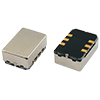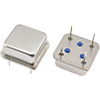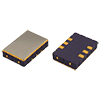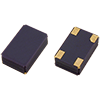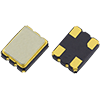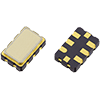The Benefits of Using VCXOs and Their Impact on Electronic Systems
27 Jul 2023
INSPIRE SERVICES
At the heart of many electronic systems are Voltage-Controlled Crystal Oscillators, more commonly referred to as VCXOs. These devices are integral to the clocking systems in many pieces of technology, offering precision, stability, and adaptability.
A VCXO, in essence, is an oscillator whose frequency is determined by a crystal, usually made from quartz, and can be slightly adjusted by applying a voltage. This unique characteristic of being tunable makes VCXOs indispensable for many applications where frequency stability and accuracy are paramount, and slight adjustments to the frequency may be necessary due to environmental conditions or specific application requirements.
The importance of VCXOs in electronics cannot be overstated. They are the core heartbeat of many electronic devices, providing a steady and adjustable clock signal that ensures all parts of the system can work in harmony.
Without VCXOs, many modern technological advancements, including telecommunications, GPS, data transmission, and even space exploration, would not be feasible.
In the remained of this blog, we will delve deeper into the fascinating world of VCXOs, exploring how they work, their advantages over fixed-frequency oscillators, their numerous applications, and why choosing the right VCXO is a critical design decision in electronics.
What are VCXOs?
Voltage Controlled Crystal Oscillators, or VCXOs, are a specific type of oscillator that uses a piece of piezoelectric material, typically a quartz crystal, as a frequency selective element. This crystal helps to provide a high stability oscillating frequency.
What sets VCXOs apart from their oscillator counterparts is their tunability; by applying a voltage, the oscillation frequency can be slightly adjusted or "pulled" from its nominal value.
But what exactly does this mean?
One key application of VCXOs is in data stream recovery. Each bit to be recovered had limited rise and fall times so only the middle part of the bit has the maximum separation between a 1 and a 0. Further added noise and jitter reduce the gap between a 1 and a 0 and jitter blurs the position of the transition between bits. In the this application the sampling of each bit has to be exactly in the middle of each bit to minimize errors while at the same time have a frequency matched to the bit rate of the bit stream. The VCXO provided this low jitter clock that can be continually adjusted to match the incoming data rate.VCXOs are extensively used across a range of applications, including telecommunications, where all frequency sources must be synchronized for correct operation, and transfer of digital audio where the source and destination must match to avoid dropped or duplicated samples.
In summary, VCXOs are the hidden conductors of the electronic world, managing the precise frequencies needed for myriad devices and systems to operate in harmony. The tunability of these oscillators makes them invaluable in a world that demands constant adaptation and precision.
How do VCXOs work?
To understand the functioning of VCXOs, we first need to delve into the core elements that constitute these devices.
A VCXO comprises an oscillator circuit, a variable capacitance (varicap) diode, and a piezoelectric crystal, typically made from quartz.
The oscillator circuit comprises an amplifier, which provides power for the oscillations, and a feedback loop with a resonator, which controls the amplitude and phase of the output from the amplifier signal and feeds it back into the amplifier input.
At the heart of this oscillator is the piezoelectric crystal, which has a naturally occurring frequency of oscillation or 'resonance'. When an alternating current is applied to the crystal, it oscillates at this resonant frequency.
Quartz crystals are particularly favoured for this purpose because of their high stability, low cost, and exceptional frequency response.
The defining characteristic of a VCXO - its tunability - is achieved through the inclusion of a varicap diode in the circuit. A varicap diode is a special type of diode that exhibits a variable capacitance based on the applied voltage.
When a voltage is applied to the varicap diode, it alters the capacitance in the crystal oscillator circuit. This change in capacitance effectively 'pulls' the resonant frequency of the crystal away from its natural resonance, causing the oscillator frequency to change slightly. This voltage-controlled adjustment of the oscillator frequency is what gives VCXOs their unique ability to 'tune' the output frequency.
It's essential to note that the pullability range of a VCXO, i.e., the range over which the output frequency can be adjusted, is typically quite small. It usually only encompasses from tens of ppm to a few hundred (ppm) of the nominal frequency. However, even this small degree of frequency adjustment can be extremely beneficial in applications where precise frequency control is required.
In essence, VCXOs offer an elegant solution to the challenge of providing a stable and precise, yet adjustable, frequency source. The ingenious combination of quartz crystals and varicap diodes in these devices allows electronic systems to maintain synchronization and adapt to changing conditions or requirements.
Advantages of VCXOs Over Fixed-Frequency Oscillators
VCXOs have carved a niche for themselves in the world of frequency control products due to their unique attributes, including flexibility, stability, and accuracy.
The external control signal of a VCXO can be combined with the internally generated temperature compensation signal of a TCXO to form a VCTCXO. These usually have smaller tune ranges than VCXOs as the extra range is not needed and having a reduced tune range improves phase noise performance.
OCXOs also usually have a tune voltage input, but the tune range is even smaller than that of VCTCXOs. This usually just used manufacturing final adjustment and correction of aging or for synchronization with other OCXOs or other precision sources such as rubidium standards or GPS time signals. The tune range in this instance is just a few ppm.
We’ve gone into detail on these advantages in more detail below:
Flexibility
The defining feature of a VCXO is its tunability, an attribute that provides the flexibility not offered by fixed-frequency oscillators.
With the application of a control voltage, the output frequency of a VCXO can be minutely adjusted or 'pulled' from its nominal value. This allows for corrections to be made in real-time to account for varying conditions, such as temperature changes, aging, or other factors that could affect the frequency stability.
Stability
The quartz crystal at the heart of the VCTCXO provides a stable and precise frequency output that is less susceptible than VCOs to environmental variations such as temperature and humidity. This stability, combined with the ability to adjust the frequency as needed, makes VCTCXOs a reliable choice for systems requiring precise frequency control.
Applications That Benefit from Using VCXOs
The unique combination of attributes that VCXOs offer—flexibility, stability, and accuracy—make them an excellent choice for a multitude of applications.
Below, we'll explore several such applications, showcasing how VCXOs from Golledge Electronics have been instrumental in enhancing system performance.
Telecommunications
In telecommunications, precise frequency control is vital for ensuring reliable communication. VCXOs serve an essential role in generating carrier signals, synchronising data transmission and receiption, and aiding in frequency synthesis.
Their ability to adapt to changing requirements makes them ideal for maintaining communication system synchronisation.
Data Transmission
In data transmission, VCXOs are often used in the clock recovery circuits of digital receivers, where they help to synchronise the receiver with the transmitter's clock signal. Their tunability is crucial here, allowing them to adjust the recovered clock to match the incoming data stream's timing exactly.
The Golledge GVXO-L58 or GVXO-H58 series is a notable choice for such applications, thanks to low jitter, wide frequency ranges and LVDS or HCSL output options.
Frequency Synthesis
In frequency synthesis, VCXOs can serve as a local oscillator in phase-locked loop circuits, allowing for the generation low phase noise output frequencies from a single reference frequency. Their low phase noise and jitter allow cleaner outputs than VCOs often at lower current.
Design Considerations for Choosing VCXOs
Selecting the right VCXO for your specific application can be a complex task, requiring careful consideration of several parameters.
Let's delve into some crucial factors that you need to keep in mind while choosing a VCXO:
Centre Frequency
Golledge Electronics offers VCXOs with a wide range of centre frequencies, allowing them to cater to a broad spectrum of applications.
Frequency Stability
Frequency stability is another critical parameter. It defines how well the VCXO maintains its frequency over variations in temperature, voltage, and load.
The stability of a VCXO can be affected by external factors such as temperature changes, power supply voltage variations, and aging. In many applications the stability eats into the tune range as the tune signal has to correct for this as well as tuning to the desired output frequency. Care should be taken over what is and is not included in the Stability definition.
Phase Noise and Jitter
Phase noise and jitter are crucial considerations for applications that require a clean and stable signal. Low phase noise and jitter are beneficial for applications like telecommunications, data transmission, and GPS systems.
Golledge's VCXOs exhibit low phase noise and jitter characteristics, contributing to their high performance.
Pullability Range
Pullability defines the range over which the VCXO’s output frequency can be 'pulled' or adjusted. A wider pullability range provides more flexibility for frequency adjustment. Care should be taken over the definition of pulling range, absolute (relative to the nominal centre frequency) or relative (relative to the current output frequency with a mid-point tune voltage).
Package Size
The physical size of the VCXO can also be a crucial consideration, especially for applications where space is at a premium. Golledge offers VCXOs in various package sizes to accommodate different design constraints. Larger package sizes generally offer room for a large crystal blank meaning is possible to achieve specific wider frequency pulling range characteristics.
Find out more about how to purchase quality products from Golledge if you are interested in elevating your electronic device’s performance.
Why Choose Golledge Electronics for VCXOs?
Here at Golledge Electronics we have cemented our reputation as a leading supplier of frequency control products, including high-quality VCXOs.
But why exactly should you choose Golledge for your VCXO needs? Here are some compelling reasons:
- Commitment to Quality:All our VCXOs are carefully designed and rigorously tested to ensure that they deliver consistent, reliable performance.
- Competitive Pricing: By leveragingourexpertise and long-standing industry relationships, we provide VCXOs at prices that make sense for your project's budget.
- Wide Range of Frequencies and Specifications:We offer a diverse product portfolio that caters to a multitude of applications.
- Reliable Build: We create VCXOs that can withstand the demands of various operating conditions and provide dependable performance over the product's lifespan.
Golledge Electronics is a trusted source for VCXOs due to our dedication to quality, competitive pricing, and a broad range of product offerings.
If you're in the market for VCXOs, we invite you to explore Golledge's comprehensive range of products. Use the product search on our website to find the exact VCXO that meets your requirements or contact our accommodating team directly to discuss your project needs in more detail.

